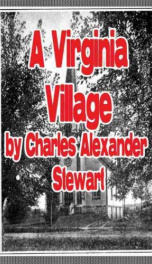A Virginia Village

From Foreword: "Charles A. Stewart's A Virginia Village is a charming depiction of the early days of Falls Church. It is the earliest attempt to put on paper the story of the Falls Church area. In addition to interesting stories about people and organizations and life generally in the small town of 80 years ago, the book contains photographs of 107 Falls Church houses, stores, and churches then standing. Reading it is a trip into nostalgia for old-timers-but the book is more than nostalgia. It pictures many elements which we associate with the community's lovely historic character and interest, and which intrigues newcomers and older residents alike. Charles A. Stewart produced the book with the help of friends, including M. M. Ogden, who wrote the preface, and Pickering Dodge, who took the photographs. Joseph H. Newell printed it in a small backyard shop owned by his father, which was located on what is today North Washington Street next to the Columbia Baptist Church. Not all of the structures standing in the town of Falls Church in 1904 are pictured in A Virginia Village. Some owners perhaps were not asked, or they did not wish to pay the two-dollar fee, or they declined for other reasons. A number of these absent structures were well-known features of the community, including the two W.&O.D. railway stations (East and West Falls Church, now gone), Mt. Hope, Shadow Lawn (or Whitehall), Tallwood, Jefferson School (no longer standing) and the old I.O.O.F. Hall (also gone). Falls Church-By Fence and Fireside, published in 1964 by the Rev. Melvin Steadman, mentions many others, such as Big Chimneys, which was still standing in 1904. Of the 107 structures pictured, 24 were located near the present City, particularly in what was then known as the "East End" or East Falls Church. This former part of the town of Falls Church was returned to Alexandria County (now Arlington) in 1936. A large number of homes, stores, and other business establishments which constituted East Falls Church disappeared with the building of I-66, especially that part of the highway that lies between Westmoreland and Sycamore Streets in Arlington County. East Falls Church extended from the present City/County line down Lee Highway, and thus was located on both the north and south sides of I-66. A review of the available records and the recollections of older residents indicates that 57 of the buildings shown are no longer standing; of the some 50 not pictured, 14 are no longer standing. Thus, of at least 157 buildings known to have been standing in town in 1904, 71 are known to have been lost (almost half).[Pg viii] The sources consulted (other than the book itself) include extensive notes made about 1970 by Mrs. John C. (Frances Butterworth) Cline, who died in 1979; Falls Church-Places and People, by Henry H. Douglas, published by the Falls Church Historical Commission in 1981 (still available in paperback); Rev. Melvin Steadman's Falls Church-By Fence and Fireside, published in 1964 (out of print); Henry H. Douglas' Falls Church Historical News and Notes, published between May 1970 and October 1972; Henry H. Douglas himself, who has made a hobby of Falls Church history; Mel and Ruby Bolster, charter members of VPIS; and many others."
Info about the book
Author:
Series:
Unknown
ISBN:
1569768064
Rating:
4/5 (3)Your rating:
0/5
Languge:
English
Users who have this book
Users who want this book
What readers are saying
What do you think? Write your own comment on this book!
write a commentif you like A Virginia Village try:
Other books by this author
Do you want to read a book that interests you? It’s EASY!
Create an account and send a request for reading to other users on the Webpage of the book!

